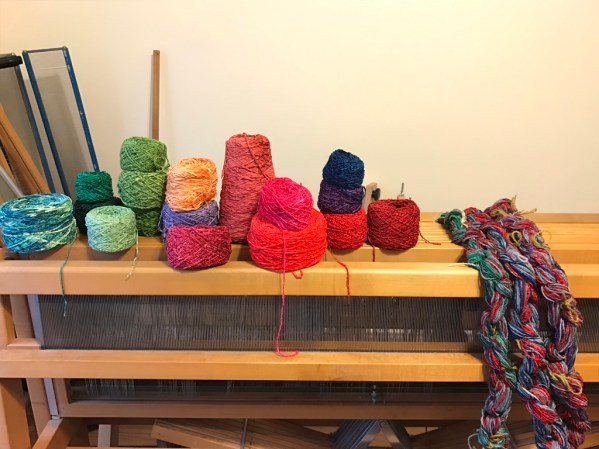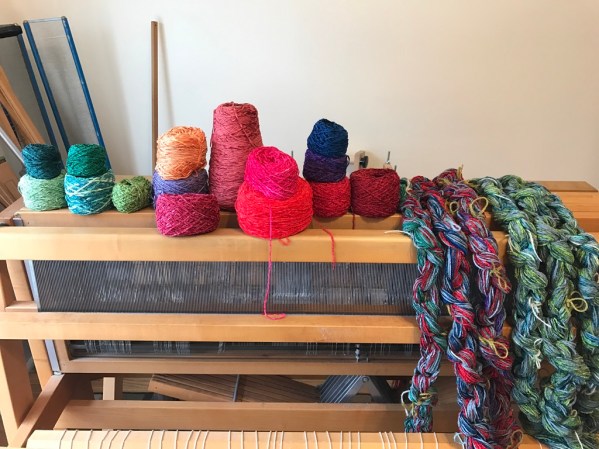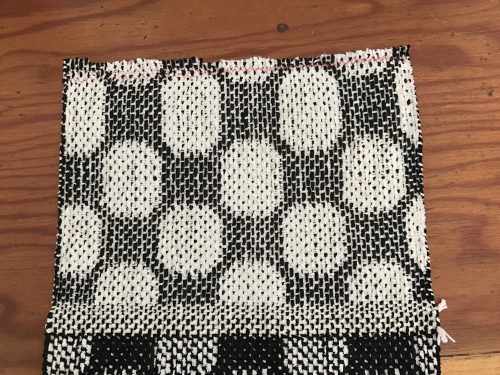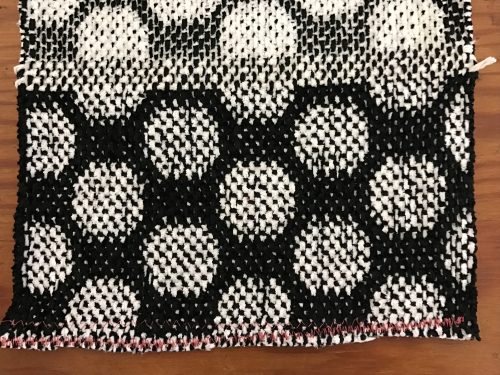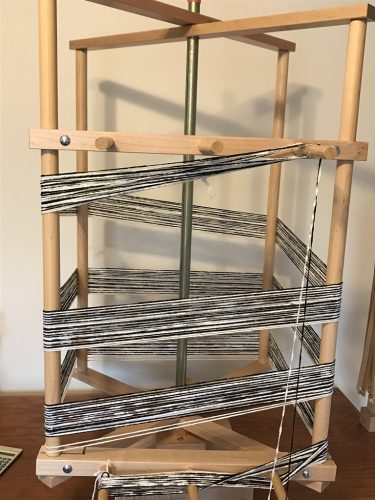Yep, I did it again. I sampled. Sorry not sorry.
Ahem, let me explain. In Marian Stubenitsky’s book Weaving with Echo and Iris there is a Turned Taqueté project of sorts using cotton chenille and 8/2 cotton together in the warp, and cotton in the weft (see page 199 -200). This is as close to a real project as Ms. Stubenitsky ever gets, since her book is more of a reference work than a how-to, but I was very curious how to make the mixed warp work with my now go-to weave structure.
My drawdown isn’t an exact copy from the book. If I had used her draft, I would have had 4-thread floats, and those are too long for rayon chenille. The chenille for the project in the book is cotton, which doesn’t pose as much of a worming risk. I took the zig zag profile draft, letting Fiberworks do its magic, and I produced a drawdown with floats no longer than 3 threads.

I own an over-supply of 1450 ypp rayon chenille, and finding ways to use it is kind of critical. The thing is, I needed to find a warp to pair with the chenille that is similar in weight and fiber. I eliminated 5/2 (too thin) and 3/2 (too thick). According to my handy Master Yarn Chart, somewhere in the world there is 4/2 cotton, and at 1680 ypp I thought that might work. But I really wanted rayon, so I asked Google if there was any 4/2 rayon in the universe, and I actually found some on eBay.
I took a flier on that 4/2 rayon, found that it was just what I needed, and painted the skeins in a colorway I use for 8/2 Tencel in my Etsy shop called Summer Melon. I paired Summer Melon with 1450 ypp gray rayon chenille and wound my warp. And yes, I added extra length for sampling. I sett it at 20 epi, and then started searching through my stash for a likely weft. I was going for thinner weft than I have ever previously used in Turned Taqueté. For drape. Because thinner weft is very often recommended for Turned Taqueté, and because I have stubbornly ignored said recommendations.
Here are my first efforts:

In the top sample I used 20/2 cotton in aqua for weft. I knew that was going to be wildly inappropriate, but I just needed a clear contrast for my next efforts. The next weft is some old dye-experiment 16/2 soysilk in a rust red. I felt that 16/2 was a size that was getting closer, but still no cigar. My gut feeling was that 8/2 rayon was really going to be the one, so I ordered some and dyed it oxblood red.

As you can see, the motifs are in better proportion. But here’s the part that I think is really significant with this mixed warp. Turned Taqueté depends on color contrasts for designs to appear in the weaving, and we have that here. In addition, there is texture contrast, which adds a whole new dimension to the structure.
After a gentle soak in Eucalon, I air dried, and the drape is very silky. Shrinkage after washing was pretty consistent for all three samples: a whopping 25%. The scarf warp that is left on the loom may be on the short side after it is all done, but I have all the information I need for future projects.
I think this is it!


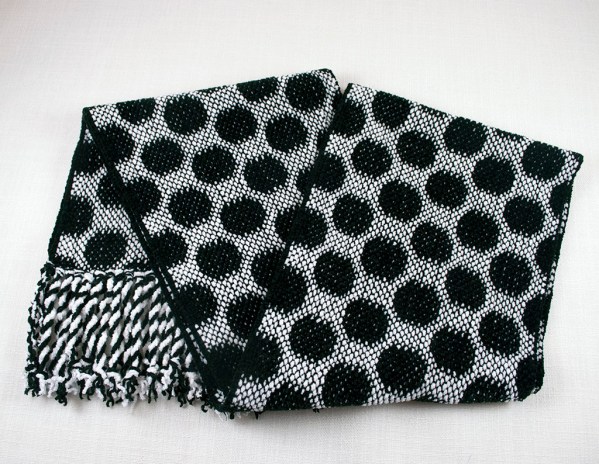
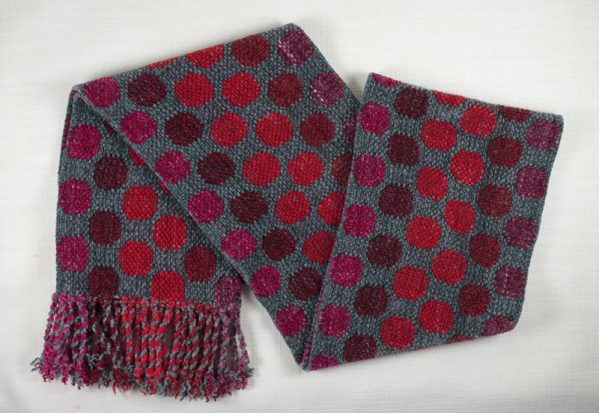




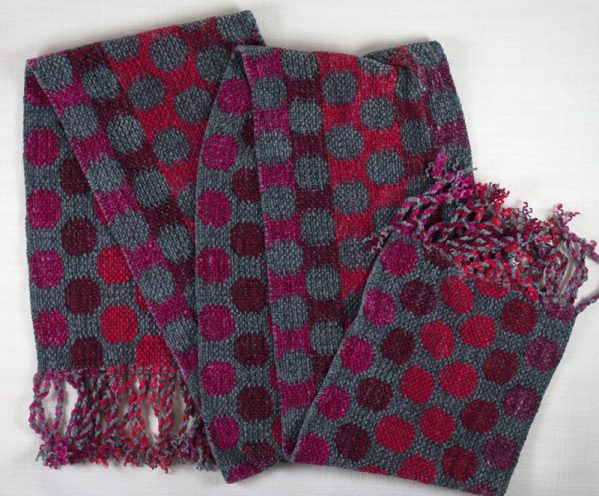

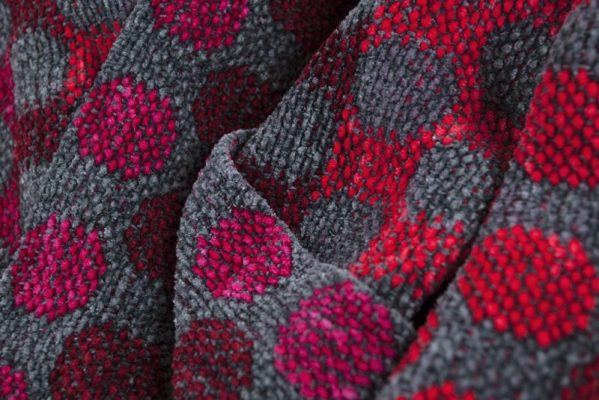

 I finished the black and white Turned Taquete Circles scarfs, and this is the one that I am keeping. It’s on the short side, and I haven’t ruled out whether to turn it into a cowl. A seam would shorten it even more, and it’s currently holding at 35″ not counting fringe.
I finished the black and white Turned Taquete Circles scarfs, and this is the one that I am keeping. It’s on the short side, and I haven’t ruled out whether to turn it into a cowl. A seam would shorten it even more, and it’s currently holding at 35″ not counting fringe.